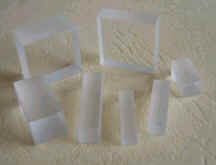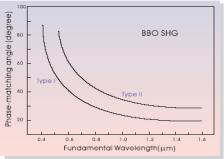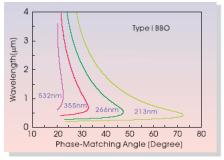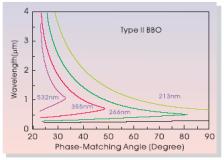|
Broadband,Inc.
〒121-0832
東京都足立区
古千谷本町4-7-9
お問い合わせ
TEL:03-5838-0082
ask@bblaser.com |
| |
|
|
●
BBO |
|
|
|
Abal
OptoTek社 (AOTK)
|
|
|
|
Beta-Barium
Borate (β-BaB2O4 or
BBO)
Beta-Barium
Borate (β-BaB2O4 or
BBO) is one of the most excellent NLO
crystals. Using
a newly improved flux method, AOTK now
produces high-quality BBO crystal with
high
optical homogeneity, no inclusion and
lower defects, lower absorption, high
damage threshold and better laser
performance.
AOTK supplies the crystal length from
0.005mm
to 20mm with various aperture and
coating.
|
 |
AOTK's
BBO Advanced Properties
●
Broad phase-matchable range from 409.6
nm to 3500 nm
●
Wide transmission region from 190 nm to
3500 nm
●
High damage threshold of 10 GW/cm2
for 100 ps pulse-width at 1064 nm
●
Large effective
second-harmonic-generation (SHG) coefficient
●
Wide temperature-bandwidth of about 55°C
●
High optical homogeneity with Δn >
10-6/cm
●
Good mechanical and physical properties
Typical Applications of BBO
●
SHG, THG, 4HG and 5HG harmonic
generations of Nd: lasers
●
SHG, THG, and 4HG harmonic generations
of Ti:Sapphire and Alexandrite lasers
●
Frequency-doubling, -tripling and
-mixing of Dye lasers
●
Frequency-doubling and -tripling of
ultrashort pulse Ti:Sapphire and Dye lasers
●
Frequency-doubling of Argon ion,
Cu-vapor and Ruby lasers
●
Optical parametric amplifiers (OPA) and
optical parametric oscillators (OPO)
Basic Properties
1. Structual and Physical Properties
|
Crystal
Structure
|
Trigonal
Point group 3m, Space group R3c
|
|
Lattice
Parameters
|
a=b=12.532Å,
c=12.717Å, z=6
|
|
Density
|
3.84
g/cm3
|
|
Mohs
Hardness
|
4.0
|
|
Melting
Point
|
1095
± 5oC
|
|
Transition
Temperature
|
925
± 5oC
|
|
Resistivity
|
>1011
ohm-cm
|
|
Absorption
Coefficient
|
α<0.1%/cm
@1064 nm; α<1%/cm @532 nm
|
|
Optical
Homogeneity
|
Δn ≈
10-6/cm
|
|
Hygroscopic
Susceptibility
|
Low
|
|
Thermal
Conductivity Coefficient
|
⊥c,
1.2W/m/K; //C, 1.6W/m/K
|
|
Thermal
Expansion Coefficient
|
a1=a2=4x10-6/oC,
a3=36x10-6/oC
|
|
Relative
Dielectric Constant
|
eT11/e0=6.7,
eT33/e0=8.1;
Tan d<0.001
|
2. Linear Optical Properties
|
Transparency
Region
|
189
- 3500 nm
|
|
Refractive
Indexes at 1064nm
at
1064 nm
at 532 nm
at 355 nm
at 266 nm
at 213 nm
|
no
= 1.6551
ne = 1.5425
no = 1.6750
ne = 1.5555
no
= 1.7055
ne = 1.5775
no
= 1.7571
ne = 1.6146
no
= 1.8465
ne = 1.6742
|
|
Therm-Optic
Coefficients
|
dno/dT
= -9.3 x 10-6/oC
dne/dT = -16.6 x 10-6/oC
|
|
Sellmeier
Equations (λ in μm, T=20
°C)
|
no2=2.7359+0.01878(λ2-0.01822)-0.01354λ2
ne2=2.3753+0.01224(λ2-0.01667)-0.01516λ2
|
3. Nonlinear Optical Properties
|
Phase
Matching Output Wavelength
|
189
- 1750 nm
|
|
Nonlinear
Coefficients
|
d11
= 5.8 x d36(KDP)
d31 = 0.05 x d11
d22
< 0.05 x d11
|
|
Effective
SHG Coefficients
|
Type
I: deff
=
d31sinθ+(d11cos3Φ-d22sin3Φ)cosθ
Type
II: deff
=
(d11sin3Φ+d22cos3Φ)cos2θ
(where θ and Φ are polar angles
referring to Z and X axis
respectively)
|
|
Electro-Optic
Coefficients
|
g11
= 2.7 pm/V, g22,
g31
< 0.1 g11
|
|
Half-Wave
Voltage
|
48
KV (at 1064 nm)
|
| , ,
Damage
Threshold
at 1064 nm
at 532 nm
at 266 nm
|
5GW/cm2
(10 ns), 10GW/ cm2 (1.3
ns)
1GW/cm2
(10 ns), 7GW/ cm2 (250 ps
)
120MW/cm2
(8 ns)
|
Main Applications
I. Applications in Nd:YAG Lasers
Base
on its superior optical and NLO properties,
BBO is the most efficient NLO crystal used for
SHG, THG, 4HG of Nd:YAG lasers. Moreover, BBO
is the ONLY NLO crystal which can produce 5HG
at 213 nm. More than 70% for SHG, 60% for THG
and 50% for 4HG conversion efficiencies have
been obtained respectively, and output 200 mW
at 213 nm. Basic NLO properties from SHG to
5HG of Type I BBO crystal are shown in Table
1, and Table 2 shown the harmonic generation
results of BBO and KD*P crystals.
Table 1. Relevant NLO Properties of
Type I BBO Crystal
|
Fundamental
Wavelength: 1064 nm
|
SHG
|
THG
|
4HG
|
5HG
|
|
Effective
NLO Coefficient (d36(KDP))
|
5.3
|
4.9
|
3.8
|
3.4
|
|
Angular
Acceptance (mrad-cm)
|
1.0
|
0.5
|
0.3
|
0.2
|
|
Walk-off
Angle (Degree)
|
3.2
|
4.1
|
4.9
|
5.5
|
|
Temperature
Acceptance (°C)
|
51
|
16
|
4
|
/
|
Table 2. Harmonic Generations using
BBO and KD*P Crystal
|
Crystal
|
1ω
(mJ)
|
SHG
(mJ)
|
THG
(mJ)
|
4HG
(mJ)
|
5HG
(mJ)
|
|
BBO
|
220
|
105
|
39
|
18.5
|
5
|
|
600
|
350
|
40
|
70
|
20
|
|
KD*P
|
600
|
270
|
112.5
|
45
|
/
|
Both
type I and type II phase-matching can
be reached by angle-tuning. The phase
matching angles of frequency doubling
determined by input radiation
wavelength is shown in Fig. 1.
BBO
is a very efficient crystal for
intracavity SHG of high power Nd:YAG
lasers. For example, greater than 15 W
average power at 532 nm was obtained
in intracavity SHG of an acousto-optic
Q-switched Nd:YAG laser with AR-coated
BBO crystal.
|
 |
Good laser beam quality (such as: small
divergence, good mode condition, etc.) is the
key for BBO to obtain high conversion
efficiency, due to BBO's small acceptance
angle and large walk-off. Tight focus of laser
beam is not recommended.
II. Applications in Tunable Lasers
Dye Lasers
Efficient
UV output (205 - 310 nm) with a SHG efficiency
of over 10% at wavelength of more than 206 nm
was obtained in type I BBO, and 36% conversion
efficiency have been achieved for a XeCl-laser
pumped Dye laser (for example, Lambda Physik's
Model LDP3000 and FL 3000) with power
150KW. The conversion efficiency is about 4 -
6 times higher than that of ADP. Furthermore,
the shortest SHG wavelength which is about 4 -
6 times higher than that in ADP. The shortest
SHG wavelength of 204.97 nm with efficiency of
about 1% has been generated.
With sum-frequency of 780 - 950 nm and 248.5
nm (SHG output of 495 nm dye laser) in Type I
BBO, the shortest UV outputs ranging from
188.9nm to 197 nm and the pulse energy of 95
mJ at 193 nm and 8 mJ at 189 nm have been
obtained respectively.
Ultrafast Pulse Laser
A
laser pulse as short as 10 fs pulse can be
efficiently frequency-doubled with very thin
BBO wafer which shows its superior properties
compared with KDP and ADP crystals,
considering both phase-velocity and
group-velocity matching. It has been reported
that 10fs 438 nm ultrafast laser has been
achieved by 0.01 mm doubling BBO crystal
wafer. Now as thin as 0.01 mm thickness BBO
wafers fabricated and supplied by AOTK are
widely used in frequency-doubling, -tripling
and autocorrelation measurient of ultrafast
pulse lasers.
Alexandrite and Ti:sapphire Lasers
UV output in the region of 360 - 390 nm with
pulse energy of 105mJ (31% SHG efficiency) at
378 nm, and output in the region 244 -259 nm
with 7.5 mJ (24% mixing efficiency) have been
obtained for type I BBO SHG and THG of an
Alexandrite laser.
Greater than 50% of SHG conversion efficiency
in a Ti:Sapphire laser has been obtained. High
conversion efficiencies were also obtained for
THG and 4HG of Ti:Sapphire lasers.
Argon Ion and Copper-Vapor Laser
By using the intracavity frequency-doubling
technique in an Argon Ion laser with all lines
output power of 2W, maximum 33 mW at 250.4 nm
and thirty-six lines of deep UV wavelengths
ranging from 228.9 nm to 257.2 nm were
generated in a Brewster-angle-cut BBO crystal.
Up to 230 mW average power in UV at 255.3 nm
with maximum 8.9% conversion efficiency has
been obtained
for the SHG of Copper-Vapor laser at
510.6 nm.
III. Applications in OPO and OPA
|

|

|
|
Fig.
2. Type I OPO Turing curves of BBO
|
Fig.
3. Type II OPO Turing curves of BBO
|
BBO is one of the most suitable materials for
optical parametric oscillators (OPO) and
optical parametric amplifiers (OPA), to
generate the widely tunable coherent radiation
from UV to IR. Type I and Type II phase
matching are applied in BBO's OPO and OPA
shown in Fig. 2 and Fig. 3.
Generally long BBO (>15mm) shall be used to
decrease the oscillation threshold when
employing the type II phase-matching scheme.
In order to obtain high efficient conversion,
input laser radiation with good beam quality
and low divergence is required because of
small acceptance angle and large walk-off.
Type I gives a larger tuning range and higher
parametric amplification rate comparing to
Type II, However, Type II interaction can
produce narrower bandwidth (0.05 nm) output
near degenerate points.
BBO
OPO can generate more than 100mJ with
wavelength tunable from 400nm to 2000nm by
Nd:YAG laser. Meanwhile, BBO OPO system cover
the tuning range from 400nm to 3100nm. A
maximum of 30% conversion efficiency can be
obtained from 400nm to 3100nm, and more than
18% conversion efficiency over the wavelength
range from 430nm to 2000nm.
Pumped by picosecond Nd:YAG at 355 nm,
narrow-band (< 0.3 nm), high energy (>
200mJ) and wide tunable (400nm ~ 2000nm) pulse
have been produced by BBO's OPA. With > 50%
conversion efficiency, BBO's OPA is superior
to common Dye lasers in efficiency, tunable
range and maintenance, and is easy to design
and operate.
With a 1 mJ, 80 fs Dye laser at 615 nm
pumping, OPA using two BBO crystals yields
more than 50 mJ
(maximum 130 mJ), < 200 fs ultrashort pulse
over 800 nm ~2000 nm.
Parametric gain of BBO is over ten times
higher than that of KDP at 355 nm pump for
Type I interaction.
Tunable OPO with signal wavelengths between
422 nm and 477 nm has been generated by angle
tuning a type I BBO crystal pumped with XeCl
excimer laser at 308 nm.
BBO's OPO pumped by fourth harmonic of a
Nd:YAG laser (at 266 nm) has been observed to
cover the whole range of 330 - 1370 nm.
IV. BBO's E-O Applications
BBO can also be used for E-O applications. It
has wide transmission range from UV to about
3500nm and it has much higher damage threshold
than KD*P or LiNbO3, More than 80W
output power and 50KHz
repetition rate have been reached by using
AOTK’s
E-O BBO crystals and Nd:YVO4
crystals as gain media. At 5KHz, its pulse has
width as short as 6.4ns,and energy of 5.7mJ or
peak power of 900 KW. It has advantages over
the commercial A-O Q-switched one, including a
very short pulse, high beam quality and size
compact as well. Although it has a relative
small electro-optic coefficient, the Half-wave
voltage is very high (48KV at 1064nm), long
and thin BBO can reduce the voltage
requirements. AOTK now can supply 20mm long
and 1mm thin high optical quality of BBO
crystal with Z-cut, AR-coated and Gold/Chrome
plated on the side faces.
Standard Size
The standard size crystals recommended by
AOTK’s engineers for various applications
are listed as follows (assuming the laser beam
diameter upon crystal is Φ2mm to Φ3mm):
1. Harmonic Generations of Nd:YAG
Lasers
|
1064nm
SHG --> 532nm
|
Type
I,
4x4x7mm, θ
= 22.8°, Φ
= 0°
|
|
1064nm
THG --> 355nm
|
Type
I,
4x4x7mm,
θ
= 31.3°, Φ
= 0°
Type
II,
4x4x7mm,
θ
= 38.6°, Φ
= 30°
|
|
1064nm
4HG --> 266nm
|
Type
I,
4x4x7mm, θ
= 47.6°, Φ
= 0°
|
|
1064nm
5HG --> 213nm
|
Type
I,
4x4x7mm,
θ
= 51.1°,
Φ = 0°
|
2. OPO and OPA pumped by harmonics of
Nd:YAG Lasers
|
532nm
Pump --> 680-2600nm
|
Type
I,
6x4x12 -15mm,
θ = 21°, Φ
= 0°
|
|
355nm
Pump --> 410-2600nm
|
Type
I,
6x4x12 - 15mm,
θ = 30°, Φ
= 0°
Type II,
7x4x15 - 20mm,
θ = 37°,
Φ = 30°
|
|
266nm
Pump --> 295-2600nm
|
Type
I,
6x4x12 - 15mm, θ
=39°,
Φ = 0°
|
3. Frequency Doubling of DYe Laser
|
670-530nm
SHG --> 335-260nm
|
Type
I,
8x4x7mm,
θ
= 36.3°,
Φ = 0°
|
|
600-440nm
SHG --> 300-220nm
|
Type
I,
8x4x7mm,
θ = 55.0°,
Φ = 0°
|
|
444-410nm
SHG --> 222-205nm
|
Type
I,
8x4x7mm, θ
= 80.0°,
Φ = 0°
|
4. Harmonic Generations of Ti:Sapphire
Lasers
|
700-1000nm
SHG --> 350-500nm
|
Type
I,
7x4x7mm,
θ = 28°, Φ
= 0°
|
|
700-1000nm
THG --> 240-330nm
|
Type
I,
8x4x7mm,
θ = 42°,
Φ = 0°
|
|
700-1000nm
FHG --> 210-240nm
|
Type
I,
8x4x7mm,
θ = 66°,
Φ,
= 0°
|
5. Frequency Doubling and Tripling of
Alexandrite Lasers
|
720-775nm
SHG --> 360-400nm
|
Type
I,
6x4x7mm,
θ = 31°,
Φ = 0°
|
|
720-775nm
THG --> 240-265nm
|
Type
I,
6x4x7mm,
θ = 48°,
Φ = 0°
|
6. Intracavity SHG of Ar+
Laser with Brewster-angle-cut BBO
|
514nm
SHG --> 257nm
|
Type
I,
4x4x7mm,
θ = 51°,
Φ = 0°,
B-cut
|
|
488nm
SHG --> 244nm
|
Type
I,
4x4x7mm,
θ = 55°,
Φ = 0°,
B-cut
|
Ultra-Thin BBO for Ultra-fast Laser
Application
Frequency Convertion of Ultrafast
Lasers
For frequency conversion of ultrafast lasers
with femtosecond (fs) pulse width, the main
concern is fs pulse broadening induced by
group velocity mismatching (GVM) or group
velocity dispersion of NLO crystal. In order
to keep efficiency frequency conversion
without significant pulse broadening, the
suggested thickness (LGVM) of crystals is less
than Pulse Width divides GVM.
Based on advanced crystal technology, AOTK is
proud to provide as thin as 0.01 mm BBO
crystals for frequency conversion of ultrafast
lasers.
|
Application
(Type I)
BBO Crystals
|
SHG
of 700 nm
|
SHG
of 800 nm
|
SHG
of 900 nm
|
THG
of 700 nm
|
|
|
|
deff
(pm/V)
|
1.296
|
1.365
|
1.408
|
0.893
|
1.101
|
1.221
|
|
GVM
(ps/cm)
|
2.721
|
1.922
|
1.401
|
8.497
|
5.676
|
4.079
|
|
LGVM
@ 10fs (micron)
|
40
|
50
|
70
|
10
|
20
|
30
|
|
Damage
threshold
@ 10fs (GW/cm2)
|
20
|
25
|
30
|
10
|
15
|
20
|
Ultra-Thin BBO Wafers
Frequency Doubling Crystal
|
Crystal
|
Clear
Aperture
|
Thickness
|
Part
No.
|
|
BBO
|
>
Φ3.5 (mm)
|
0.01
(mm)
|
BUT6211
|
|
BBO
|
|
0.02
(mm)
|
BUT6212
|
|
BBO
|
|
0.03
(mm)
|
BUT6213
|
|
BBO
|
|
0.05
(mm)
|
BUT6215
|
|
BBO
|
>
Φ3.5 (mm)
|
0.1
(mm)
|
BUT6210
|
|
BBO
|
|
0.1
(mm)
|
BUT6220
|
|
BBO
|
|
0.5 (mm)
|
BUT6250
|
|
BBO
|
|
1.0 (mm)
|
BUT6290
|
Frequency Tripling Crystal
|
Crystal
|
Clear
Aperture
|
Thickness
|
Part
No.
|
|
BBO
|
>
Φ3.5 (mm)
|
0.01
(mm)
|
BUT6311
|
|
BBO
|
|
0.02
(mm)
|
BUT6312
|
|
BBO
|
|
|
BUT6313
|
|
BBO
|
|
0.05
(mm)
|
BUT6315
|
|
BBO
|
|
0.1
(mm)
|
BUT6310
|
|
BBO
|
|
0.2 (mm)
|
BUT6320
|
|
BBO
|
|
0.5 (mm)
|
BUT6350
|
|
BBO
|
|
1.0 (mm)
|
BUT6390
|
Frequency Quadrupling Crystal
|
Crystal
|
Clear
Aperture
|
Thickness
|
Part
No.
|
|
BBO
|
>
Φ3.5 (mm)
|
0.01
(mm)
|
BUT6411
|
|
BBO
|
|
0.02
(mm)
|
BUT6412
|
|
BBO
|
|
0.03
(mm)
|
BUT6413
|
|
BBO
|
|
0.05
(mm)
|
BUT6415
|
|
BBO
|
|
0.1
(mm)
|
BUT6410
|
|
BBO
|
|
0.2 (mm)
|
BUT6420
|
|
BBO
|
|
0.5 (mm)
|
BUT6450
|
|
BBO
|
|
1.0 (mm)
|
BUT6490
|
Mounting
Super
polished or coated crystal surfaces are very
easy to be damaged during transportation or
handling when needed, especially for thin
crystals. In order to prevent crystals from
damaging or to be easily operated, AOTK
provides three kinds of mount to install
different dimension crystals. Custom made
mounts or holders are also available.
Please contact our sales for more
information.
|
Part
No.
|
|
Thickness
(mm)
|
Crystal
Aperture (mm)
|
Crystal
Length (mm)
|
|
BH101
|
25.4
|
5.0
|
4x4-10x10
|
0.1-2
|
|
BH102
|
25.4
|
9.5,
13.5
|
4x4-10x10
|
4-10
|
|
BH103
|
25.4
|
9.5
|
8x8-10x10
|
3-6
|
Standard Fabrication Specifications
|
Dimensional
Tolerance
|
(W
±
0.1mm) x (H ±
0.1mm) x (L +0.2/-0.1 mm)
|
|
Wavefront
Distortion
|
<
λ/8 @633 nm
|
|
Angle
Tolerance
|
Δθ
< ±
0.2°,
ΔΦ< ±
0.2°
|
|
Flatness
|
λ/10
@633 nm
|
|
Surface
Quality
|
10/5
Scratch/Dig per MIL-O-13830A
|
|
Parallelism
|
<
10
arc seconds
|
|
Perpendicularity
|
<
5 arc minutes
|
|
Clear
Aperture
|
>
90% central area
|
|
Quality
Warranty Period
|
one
yea, r under proper use
|
Coatings
1. Protective Coatings (P-Coating)
The polished surfaces of BBO are relatively
easy to be fogged in humid air because of its
low hygroscopic susceptibility. The protective
coating (P-coating) was developed by AOTK to
prevent BBO from exposur, e to moisture. The
P-coated BBO with a mount is simpler and
better than BBO with housing.
Significant advantages of P-coating show as
following:
Better transmittance: Transmittance
of P-coated BBO is better than that of
uncoated BBO
over
a wide wavelength range from 200 nm-3500 nm
High damage threshold: Over 7
GW/cm2 with laser pulse-width 30ps at 1064nm.
Long Lifetime: More than 6
months at 95% humidity and much longer at
lower humidity.
2. Anti-Reflective Coatings
(AR-Coating)
AOTK supplies single-band and dual-band
AR-coatings for BBO at 1064 nm and 532 nm (at
800nm and 400 nm). The AR-coatings are
characterized by low reflectance (less than
0.15% at 1064 nm and 0.4% at 532 nm), high
damage threshold, anti-moisture and long
durability. High damage threshold AR-coatings
for 4HG of Nd:YAG or Nd:YLF laser are
developed with R < 0.2% at 532 nm and R
< 0.4% at 266 nm. AR-coatings at other
wavelengths are also available upon request.
Note
●
BBO has a low susceptibility to
moisture. Users are advised to provide dry
conditions for both use and
preservation of BBO.
●
BBO is soft and therefore the
protection of its polished surfaces requires
precautions.
●
When angle adjusting is necessary, keep
in mind that the acceptance angle of BBO is
small.
●
AOTK's engineers can select and
design the best crystal for you if parameters
of your laser are
provided, for
example, energy per pulse, pulse width and
repetition rate for a pulsed laser,
power for a CW laser, laser
beam diameter, mode condition, divergence and
wavelength tuning
range, etc.
●
Keep BBO crystals in a certain t,
emperature, it will incr, ease the damage
threshold.
|
|
|
AOTK紹介ページへ戻る▲
取扱製品一覧へ戻る▲
|
|
|
|